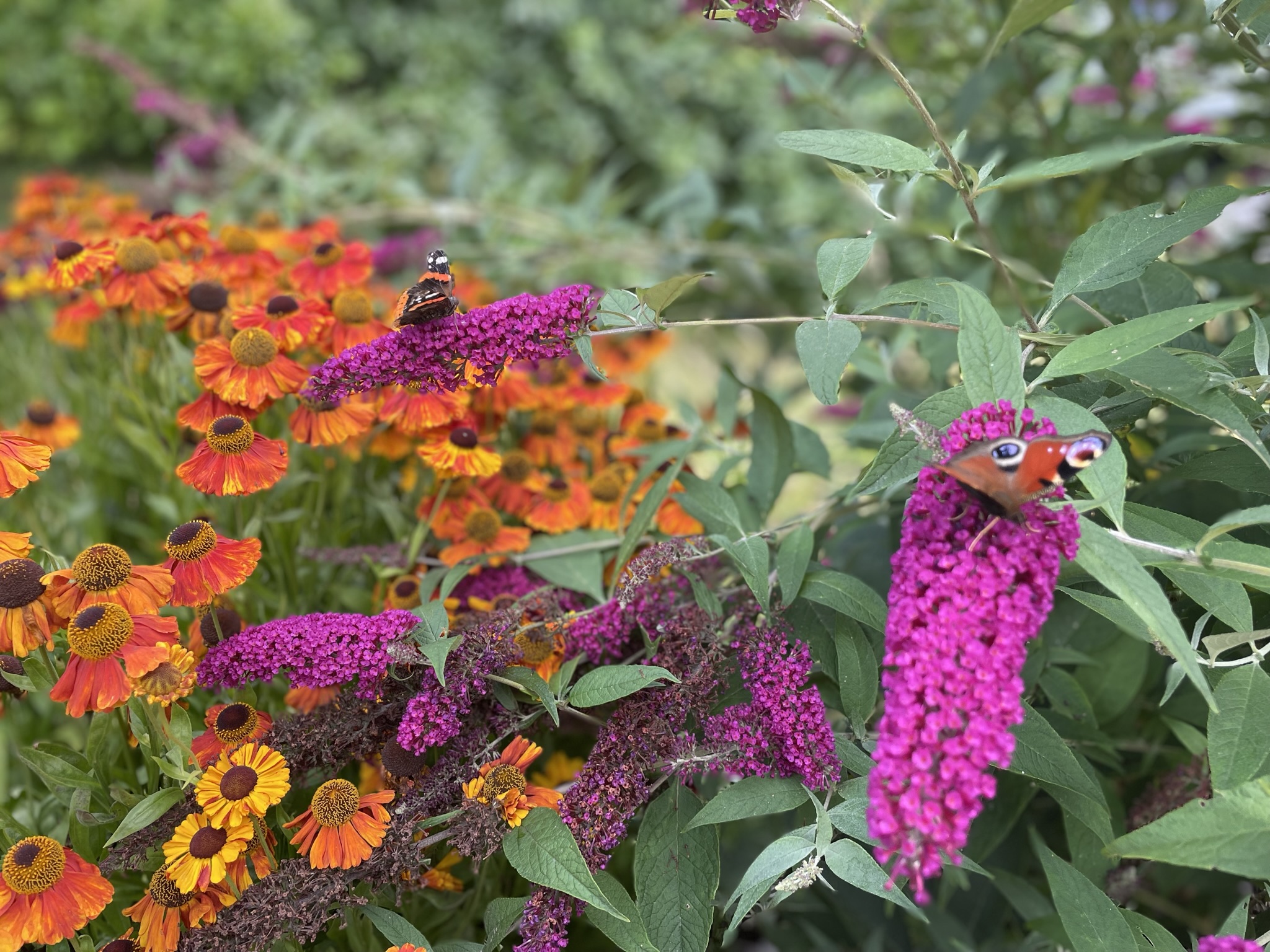
After a warm, sunny & dry June, July’s weather has been more variable. It was good to see the annuals and more tender plants coming into bloom. Pots were planted up and the Zantedeschias brought out from the greenhouse also brought splashes of colour.


The roses continued to bloom, although this year, they seemed to come and go quite quickly. They’ve been deadheaded, so the repeat-flowering roses are coming out again. The rambling roses have continued to bloom throughout the month though. Crimson Shower is especially prolific, being admired here by Hywel and Heulwen, our Magpie ducks.

The Gunnera and Elecampagne have also been very busy gaining height!


While it’s nice to enjoy the floral displays around different parts of the garden it’s also interesting to take a closer look at what else is going on. We try to choose plants that are attractive to bees, butterflies and other pollinating insects, as well as look pretty, ideally with a good perfume too.
Helenium are one of my favourite perennials. They seem to be pretty hardy and when planted in groups of three in a border, provide a stunning block of colour that lasts for ages (see the main picture above). But if you stop by and look at them more closely, you can see that they are covered in different insects. Below, you can see in turn, a European Paper Wasp, a Honey Bee with the Paper Wasp and (I think) a Red-tailed Bumblebee.




Bees love lavender of course and I like the colour combination of the purple with a yellow of an Achillea. Together, they’re real insect magnets, shown below with a Red Soldier Beetle on the Achillea.


Santolina and Rambling Rosie (another vigorous rose) also look great together. Get down to look at the Santolina and there will be plenty of bugs to see – like this one here below with a Marmalade Hover Fly.


Another flower popular with insects is Eryngium, or Sea Holly. You’d think it would be too spiky, but the Red Soldier Beetle, Bumblebee and (I think) a hover fly don’t seem to mind.

Ladybirds, like this common 7-spot one below, are definitely to be encouraged as they munch through plant pests for us. I haven’t seen as many as last year though.


Below is possibly the strangest photo in the blog. Yes, it’s of a very large plant pot (for a conifer) with a hole in the soil at the edge. We sat and watched a Leaf cutter bee flying in and out of this at roughly 7-minute intervals over an hour, each time bringing a quite large section of a leaf (probably from the roses) in its undercarriage and taking it down into the hole. Females use the bits of leaf they’ve munched off to form ‘nests’ to lay their eggs in. The bees are solitary and like a sunny spot in the garden – and they are really valued as pollinators. The young bees should emerge next year. We didn’t get a photo, but you can see what they look like here: https://www.beebombs.com/beelog/leaf-cutter-bee

One of the very best plants for butterflies and other insects has to be the Buddleja. The ‘common’ buddleja is a bit too much of a nuisance but the Buddleja ‘Buzz’ varieties are smaller, more well behaved and have more intense colours. They can be grown in a border or in pots so you can grow them in any sunny spot. We have five growing on a small patio along with Verbena bonariensis which is a bit of a thug in seeding itself to grow in cracks in the paving, but again, bugs love it! So this collection of plants, along with some wood pallet fencing which gets very warm in the sunshine, means that the patio has constant movement with butterflies and other buggy visitors. Here’s a compilation:






July has been quite a windy month so it’s been difficult to get decent pictures when everything is swaying, but here are three others who kindly stood still for long enough.



It’s also worth looking closely into some of the other blooms too. The single, open yellow flowers of the rose Tottering by Gently seem to provide a handy lair for the Flower Crab Spider. These spiders can alter their colour to match the flower they’re hiding in – they don’t spin webs, they just lurk and then run out and grab the unsuspecting moth, bee or butterfly. This one is munching on a hoverfly.

We didn’t have to look too closely to see these insects below, although it was difficult to capture the scale without running to get a ruler before they hopped off! The common grasshopper on our kitchen wall was quite small at around 2.5cm but the Great Green Bush Cricket sitting on our dustbin lid was a whopping 6-7cm!


To put it in perspective, the cricket was bigger than this little toad I uncovered in a shady corner. You can just make it out in the centre of the image on the left, enlarged on the right. These are quite common around the garden and they enjoy tasty slugs.


What we have enjoyed watching most during July is the Hummingbird Hawk Moth. This really does look like a small hummingbird, with its very long proboscis seeking out the nectar of the flowers as it hovers above them, as you can see in the photo below.

Watch it in flight in this short clip.
So that’s our garden in July. If you’re sick of hearing about it, please do send in something about your garden for August!
Maggie Kirk
Garden: Pitton
We aim to post a garden blog each month. Let us have a peep into your garden – a favourite corner, a favourite plant, what’s growing, what’s not – and share your photos and comments. Please get in touch by email (rhossilihwb.cymru@gmail.com) or contact Maggie or Isobel directly and we can chat about bringing your garden to life on the Hwb!

